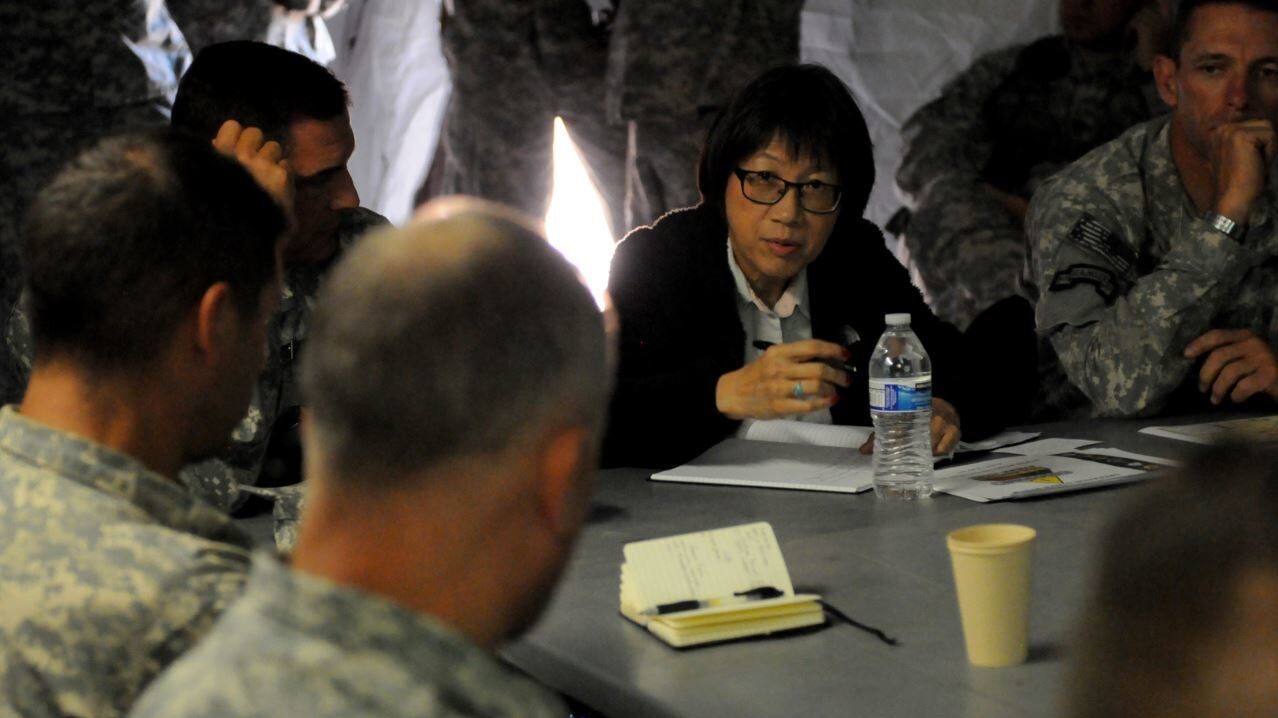
Assistant Secretary of the Army for Acquisition Logistics and Technology, Hon. Heidi Shyu, sits down with key leaders during a visit to the Fort Bliss during Network Integration Evaluation 15.2. (DVIDS)
WASHINGTON: With congressional funding still in limbo, the Pentagon’s chief technology officer is pushing forward with a new joint experimentation initiative aimed at addressing capability gaps and emerging technology, betting it’ll get the money it needs and then some.
Undersecretary for Research and Engineering Heidi Shyu told a virtual Defense Writers Group that her office is already doing initial planning for the first “sprint” of the Rapid Defense Experimentation Reserve (RDER) while waiting for congressional appropriators to reach a funding agreement on the final FY22 National Defense Authorization Act, which was signed by President Joe Biden in December.
She plans on doing two RDER demonstrations per year and wants to focus on 32 initial technology projects in the first sprint next fiscal year, ranging from both classified and unclassified efforts.
Although Shyu did not elaborate on the projects, she has previously mentioned some joint capability gaps the RDER fund could help solve include the areas of all-domain command and control, contested logistics and long-range fires.
RELATED: Pentagon R&D czar ‘looking for money’ for 32 new tech projects
The Defense Department will be able to do “quite a bit” with the initial funding, Shyu said. “They’re actually plussing me up more than I asked for.”
Shyu did not specify exactly how much funding she has asked Congress for RDER in FY23, but said it was less than $1 billion.
Looking Way Beyond 5G, And Across The ‘Valley of Death’
Shyu also told reporters a list of her top technology priorities could be released as early as next week. She’s previously revealed a few of her focus areas, including trusted artificial intelligence, integrated network systems and hypersonics.
The technology strategy will include 14 focus areas, and she’ll be filling new positions in her office to help shape the standards for each.
“For example, in emerging technology, it’s not just 5G I’m looking at,” she said. “I’m looking at [the] next [generation], right? But what you really want to look at as well is what is [the] critical enabling technology that 6G, and possibly 7G, that you want to develop today so you can shape the standards? Because otherwise you’re just always playing catch up, right?”
Shyu added she recently hired someone as the “director of next-G” who will oversee that domain.
One of Shyu’s main objectives has been trying to pave over the dreaded technology “valley of death” between the lab and battlefield. She told reporters she would be briefing Secretary of Defense Lloyd Austin today on a strategy she created to help bridge that gap.
RELATED: Silicon Valley warns the Pentagon: ‘Time is running out’
One of the ways DOD can address the issue is by funding multiple tranches of phase two Small Business Innovation and Research (SBIR) funding, Shyu said. She added the Pentagon in its FY23 budget request is asking to fund three “tranches” of phase II SBIR funding.
“A lot of times you’re providing, let’s say, $1.5 million to build a prototype. Well what if that wasn’t enough money?” she said. “Okay, so that means you’re… halfway through to a prototype, but you need additional money to finish it. So, I want to give an opportunity to provide additional funding within the SBIR program to help [companies] complete the prototype.”






















